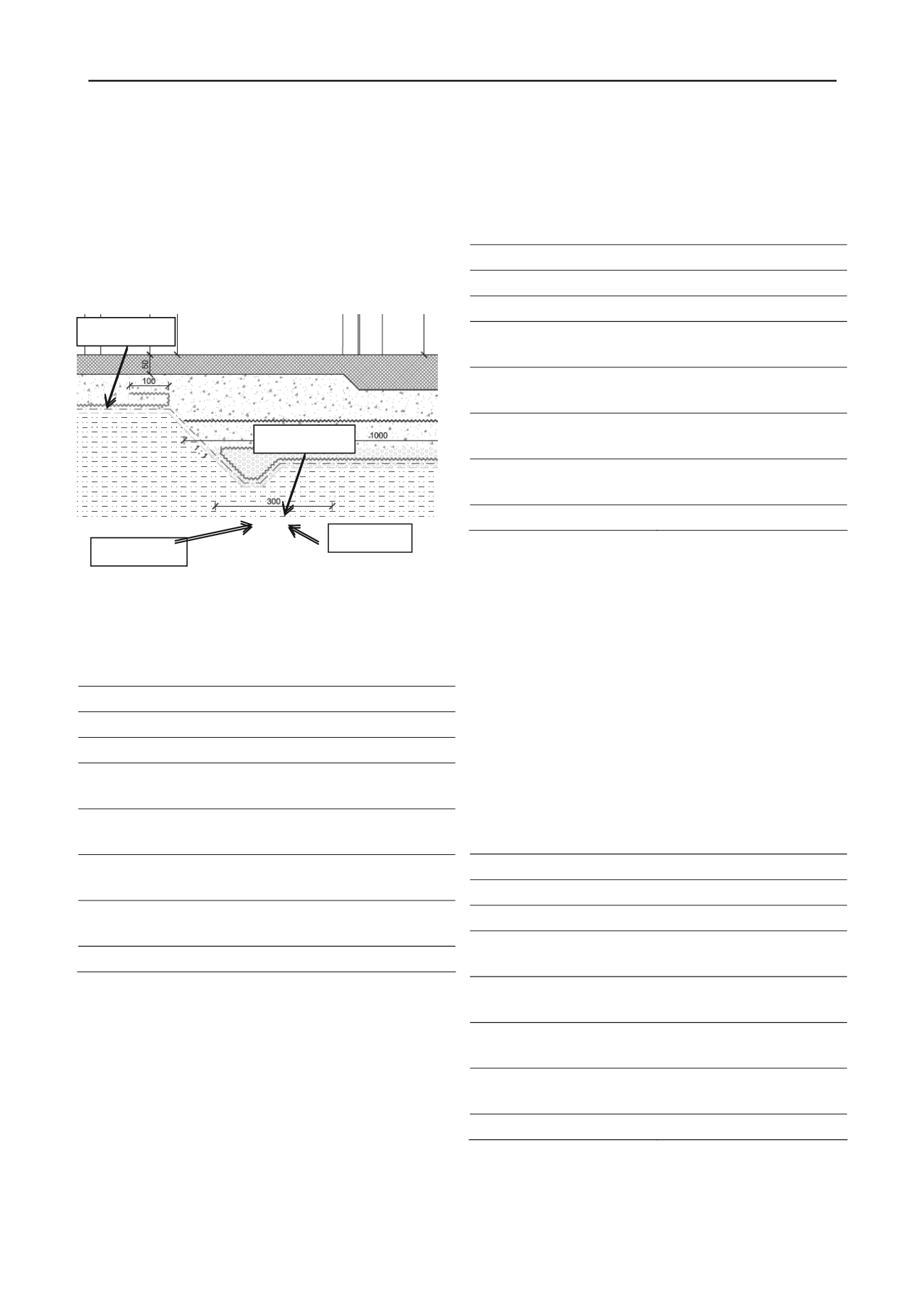
2471
Technical Committee 211 /
Comité technique 211
5.2 Geogrids and fill material
For increasing the bearing capacity of the subsoil under the
foundation slab, geogrids are inserted as reinforcement. For
reinforcement three layers of geogrids with different properties
are placed in the fill material at different elevations.
The first layer of the geogrids was installed under the
middle section of the building where the contact pressure has
maximummean value up to P=100 kPa.The geogrids installed
on this position give the geotextile anadditional tensile strength,
as well as bursting and puncturing resistance.
Figure 4. Cross section of the soil improvement measures
On other hand this first layer provides initial stiffness of the
low lifts of the fill material. The overlap oftwo adjacent panels
is 50 cm and anchoring length of 3.0 m. The properties of the
first layer of geogrid are shown in the Table 3.
Table 3. Properties of the geogrid 40/40 (first layer of geogrids)
Raw material
PP
Coating
Polymer
Weight
~ 330 gr/m2
Ultimate tensile strength
Longitudinal ≥ 40 kN/m
Transversal ≥ 40 kN/m
Tensile strength at 2% strain
Longitudinal ≥ 16 kN/m
Transversal ≥ 16 kN/m
Tensile strength at 5% strain
Longitudinal ≥ 32 kN/m
Transversal ≥ 32 kN/m
Strain at nominal tensile
strength
Longitudinal < 7%
Transversal < 7%
Mesh size
40 x 40 mm
Over this geogrid a layer of drainage fill material was
placed with thickness of 50 cm. This material has particlessize
from 16 to 32 mm.
This layer of drainage fill material is foreseen to reduce the
possibility of liquefaction. So in case of earthquake, the
building up of the pore water pressure will be reduced by
draining the water from the subsoil layers into the drainage
layer placed with the subsoil replacement works.
Over this drainage fill material, another geogrid was placed
but this time with higher strength properties. The use of this
geogrid is to reinforce the fill material as well as to ensure
additional stiffness, which is gradually increasing from the
bottom of the excavation pit up to the foundation slab.
Furthermore, this geogrid will ensure reaching of the requested
modulus of compressibility of the upperlayers of fill material.
The properties of the second layer of geogrid are shown in the
Table 4.
Table 4. Properties of the geogrid 80/30 (second layer of geogrids)
Raw material
PET
Coating
Polymer
Weight
~ 350 gr/m2
Ultimate tensile strength
Longitudinal ≥ 80 kN/m
Transversal ≥ 30 kN/m
Ultimate tensile strength at
3% strain
Longitudinal ≥ 22 kN/m
Ultimate tensile strength at
5% strain
Longitudinal ≥ 40 kN/m
Strain at nominal tensile
strength
Longitudinal < 8.5%
Transversal < 8.5%
Mesh size
20 x 20 mm
Geogrid 20/20
Geogrid 80/30
On top of the second geogrid two lifts of fill material are
done with thickness of 30 cm, total of 60 cm. The required
modulus of compressibility on top of these two layers of fill
material should be at least 100 MPa and minimum 98%
compaction after Proctor. The fill material is crushed stone base
aggregate.
On the extended parts of the building where the contact
pressure has maximummean value up to P=20 kPa, also a
geogrids is installed. This geogrid has an ultimate tensile
strength of 20 kN/m in both directions. The overlap of two
adjacent panels is 60 cm and the anchoring length is 1.0 m.
After installation of this geogrid the fill material is placed and
compacted in 30 cm thick lifts. The final layer of the fill
material at the extended parts of the building should reach at
least 80 kPa and minimum 98% compaction after Proctor.
After completion of the earth works ground improvement
measures were completely finished. So the works for hydro
insulation and constructing the structure commenced.
Table 5. Properties of the geogrid 40/40 (first layer of geogrids)
Raw material
PP
Coating
Polymer
Weight
~ 190 gr/m2
Ultimate tensile strength
Longitudinal ≥ 20 kN/m
Transversal ≥ 20 kN/m
Tensile strength at 2% strain
Longitudinal ≥ 8 kN/m
Transversal ≥ 8 kN/m
Tensile strength at 5% strain
Longitudinal ≥ 18 kN/m
Transversal ≥ 18 kN/m
Strain at nominal tensile
strength
Longitudinal < 7%
Transversal < 7%
Mesh size
40 x 40 mm
Geogrid 40/40
Geotextile


